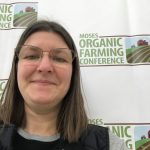Study Overview
The goal of the qualitative research study is to investigate information challenges faced by US-based farmers currently engaged in direct sales to consumers or who need to pivot to direct sales due to the COVID-19 pandemic. Our research findings will inform the design of a community food resilience toolkit consisting of digital tools and processes for farmers and consumers for local coordination of food production and distribution. This study will be supplemented with non-human subjects research – a functional evaluation of the technology landscape and a review of current community mobilization efforts – that will also inform subsequent design and development activities.
We will conduct a brief qualitative study consisting of in-depth semi-structured interviews to map the flow of food and information from “seed to market” and a brief questionnaire to collect essential demographic information.
We seek participation from two groups: (1) FARMERS and (2) farm advisors, community organizers, and coordination tool developers, aka FARM SUPPORTERS. Farmers will provide a first hand account of how they are affected and coping whereas Farm Supporters will provide guidance of how farmers are affected and coping, as well as how different organizations are supporting farmers. Note: Farm Supporter interviews are underway, but we will not start Farmer interviews until Winter 2020/2021.
We plan to speak with a minimum of 10 urban, 10 peri-urban, and 10 rural farmers in each of the five regions of the United States, defined by the United States Department of Agriculture, Agricultural Research Service’s service Regions (listed below). We seek a minimum of 12 farm supporters that cover the range of categories (listed below).
Who was eligible to participate?
FARM SUPPORTER interviews are underway and FARMER interviews will start in Winter 2020/2021. Eligibility for participation in this study for each group is determined by the following inclusion criteria.
The FARMER is the primary decision maker at a farm where the following are true:
- The farm produces the following kinds of food for human consumption.
- The farm is either online, going to go online, or have enough product and interest in going online.
- The farm is either currently engaged in direct sales to consumers, OR is now intending to pivot to direct sales to consumers due to COVID-19 related disruptions. Distribution methods can be via: online retail, farmers market, Community Supported Agriculture (CSA) shares, on-farm pickup, and distribution via a third-party distribution method such as a food hub marketplace, farm aggregator tool, or via a restaurant/grocery store that is serving as a distribution hub for consumer purchasing.
- The farm is located within the United States.
A FARM SUPPORTER is a person whose work is directly in support of previously defined FARMER. Farm supporters may fall into one or more of the following categories:
- Extension educators, agents, and specialists, farmer advocacy group representatives, and farm advisors.
- Researchers and subject matter experts on community food systems, agricultural economics, agricultural technologies, and related topics.
- Community organizers, food hub coordinators, and other advocates for community food systems.
- Local food buyers (co-ops, restaurants, grocery stores), distributors, and others involved in local food logistics.
- Agricultural sales representatives, and other members of the agricultural industry.
- Farm software developers, designers, and other members of the agricultural technology sector.
What was our regional coverage?
We will begin with the Midwest Area for a COVID-19 response within our community. Our recruitment strategy will be broad and ongoing such that we will incorporate data from any new USDA area as soon as we reach our minimum quota of 30 farmers across urban, peri-urban, and rural spaces. By setting minimum quotas, we will ensure that our ultimate analysis reflects a breadth of geographic experience. The five sample regions are:
- Northeast Area
- States Include: Connecticut, Maine, Massachusetts, New Hampshire, Rhode Island, Vermont, New Jersey, New York, Pennsylvania, Virginia, District of Columbia, West Virginia, Delaware, Maryland
- Midwest Area
- States Include: Illinois, Indiana, Michigan, Ohio, Wisconsin, Iowa, Minnesota, Missouri, Kentucky
- Southeast Area
- States Include: Florida, Georgia, North Carolina, South Carolina, Alabama, Mississippi, Tennessee, Arkansas, Louisiana, Puerto Rico
- Plains Area
- States include: Kansas, Nebraska, North Dakota, South Dakota, Colorado, Montana, Texas, Oklahoma, New Mexico, Wyoming
- Pacific West Area
- States Include: Arizona, Idaho, Nevada, Utah, Alaska, California, Hawaii, Oregon, Washington
Recruitment of Farmer or Farm Supporters, 2020-22
Once you have signed up for an interview, we will reach out to confirm eligibility, schedule a time, and provide followup information. We look forward to speaking with you!
Feel free to share this call for participation with your community:
We’re working on a toolkit for community food resilience, in times of the COVID-19 Pandemic and beyond. We’re looking for farm advisors, and community organizers to guide what we design and build. Learn more https://resilientfood.org/ or sign up for an interview https://bit.ly/talkaboutfood!
Why two hours?
Thirty in-depth interviews from a region will allow us to deeply understand the issues faced by farmers to the point that we can begin developing solutions in a way that surveys of hundreds of farmers could not. We’ve provided you with a high-level overview of the farmer interview prompts (below) so that you know what we’ll be discussing.
We understand that two hours may not be possible for your during this very busy season and are willing to work with your schedule in a number of ways, including splitting the interview up into two one-hour interviews and meeting at any time of day (or night) that is best for you. If you want to contribute to the project with an interview but cannot provide an interview now, sign up anyway and let us know that you’re not available until later on.
Farmer Interview Prompts
- Prior to Crisis
- Farm Background
- Farm Management
- Distribution & Logistics
- Recordkeeping
- Information & Food Flow Mapping: a guided activity.
- The Crisis
- Impacts on you:
- Changes in production
- Changes in distribution
- Changes in labor
- Resource availability
- Needs
- Looking Forward
- What happens next?
- For you?
- For your community?
- Changes you expect?
- Changes you desire?
Researcher?!
Are you a researcher exploring community coordination, farmer perspectives, digital technologies, or other aspects of local food systems? Our research team, led by Purdue University, has a range of collaborative activities planned, beginning with a qualitative research study to inform the design of technologies and technology-mediated processes for community food resilience.
Please email Ankita Raturi (ankita@purdue.edu) and Juliet Norton (jnnorton@purdue.edu) to set up an informational call to learn more details on the study and chat about ways to collaborate! We’re particularly looking for leadership in the 5 agricultural regions mentioned above, as well as leadership on the informatics side (HCI, software engineering, CSCW).
Leadership Team (Join us!)
Ankita Raturi
Asst. Prof. @ Agricultural Informatics Lab, Purdue University
Juliet Norton
Post-Doc @ Agricultural Informatics Lab, Purdue University
Tamara benjamin
Diversified Food & Farming Systems, Purdue Extension
andrew flachs
Asst. Prof, Anthropology, Purdue University
Michael O’donnell
Organic & Diversified Agriculture, Purdue Extension
Join the conversation!
Want to learn more our work and attend community calls?

















